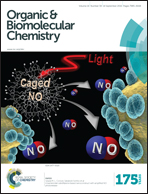Bi(OTf)3-catalyzed addition of isocyanides to 2H-chromene acetals: an efficient pathway for accessing 2-carboxamide-2H-chromenes†
Abstract
Bismuth triflate (Bi(OTf)3) is identified as an efficient catalyst for the direct addition of isocyanides to 2H-chromene acetals. The large scope of isocyanides and chromene acetals makes them suitable substrates in this catalytic system. By this synthetic strategy, a polyfunctional molecular scaffold, 2-carboxamide-2H-chromenes could be prepared efficiently in one step up to 95% yield. In addition, this efficient and practical protocol proceeded smoothly in the gram scale even when the catalytic loading was reduced to 2 mol%.



 Please wait while we load your content...
Please wait while we load your content...